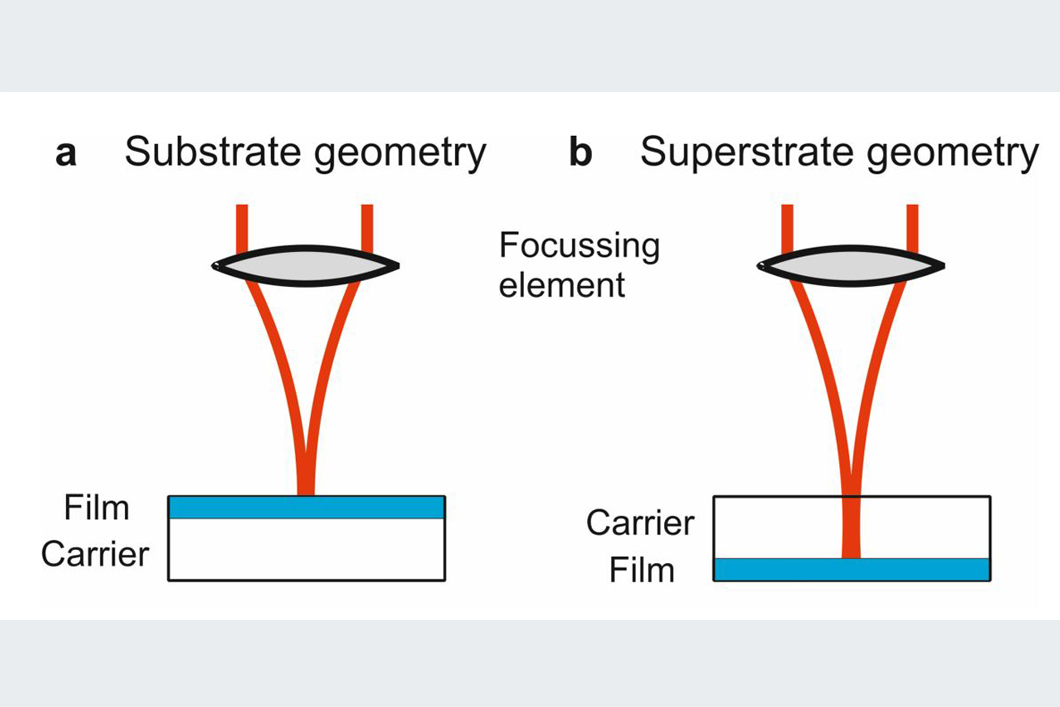
Approaches for laser processing of thin films on a carrier through a focusing element (e.g., lens, concave mirror, diffractive optical element, etc.). a Substrate geometry: laser beam is incident to the air/film interface. b Superstrate geometry: laser beam is incident through the transparent carrier to the carrier/film interface. (from J. Bonse, J. Krüger, Applied Physics A 129 (2023) 14, published under Creative Commons BY 4.0 license).
Source: BAM, Division Interfacial Processes and Corrosion
On the occasion of the 50th anniversary of the journal Applied Physics, which has been published since 1981 as Applied Physics A (Solids and Surfaces) and Applied Physics B (Photophysics and Laser Chemistry), invited contributions have been compiled in a special issue, from recipients of the Julius Springer Prize for Applied Physics, authors of the most cited papers, and past and present journal editors. It is gratifying that such an invitation was issued to Jörn Bonse and Jörg Krüger from BAM, recognizing highly cited articles in Applied Physics A, including a 2002 publication that is now among the ten most cited in Applied Physics A.
Modern life and global communication would not be possible without technologically tailored thin films; they are ubiquitous in daily life applications. In most cases, the layers are completely deposited on the carrier substrates in one processing step. Sometimes, however, partial removal or modification must be performed locally, i.e., site-controlled and material-selective, by an additional laser processing step. For this purpose, ultrashort laser pulses with durations in the femtosecond and picosecond range offer unique advantages and possibilities in industrially scalable systems. The review article provides an overview of the current state of research and corresponding industrial transfer related to structuring of thin films with ultrashort pulsed lasers. It focuses on the relevant historical developments, highlights the significant physical and chemical effects, explores the limitations, and discusses selected industrial and scientific applications.
One of the images in the review article was also selected by the journal as the front cover of the January 2023 issue of Applied Physics A. It shows an example of the successful use of ultrashort laser pulses for the fabrication of special micro concentrator solar cells, a process developed in collaboration with partners from the Leibniz Institute for Crystal Growth Berlin and the University of Duisburg-Essen as part of a third-party funded project supported by the German Research Foundation (DFG).
On such and similar topics of laser materials processing, a symposium with the subject "Making light matter: lasers in material sciences and photonics" will be held in Strasbourg (France) in May/June 2023 of which the BAM is the main organizer. The symposium is part of the traditional Spring Meeting of the European Materials Research Society and as such the oldest of its kind in Europe. Every year, it brings together scientists and engineers from research in the fields of laser materials processing and materials sciences with experts from industry and other interested parties.
Symposium L “Making light matter: lasers in material sciences and photonics”, 2023 Spring Meeting of the European Materials Research Society, 29.05. – 03.06.2023, Strasbourg, FranceStructuring of thin films by ultrashort laser pulses
Jörn Bonse, Jörg Krüger
Veröffentlicht in Applied Physics A, Vol. 129, Aufsatznummer 14, Seiten 1-38, 2023, Open Access
BAM Department Materials Chemistry
BAM Division Interfacial Processes and Corrosion


